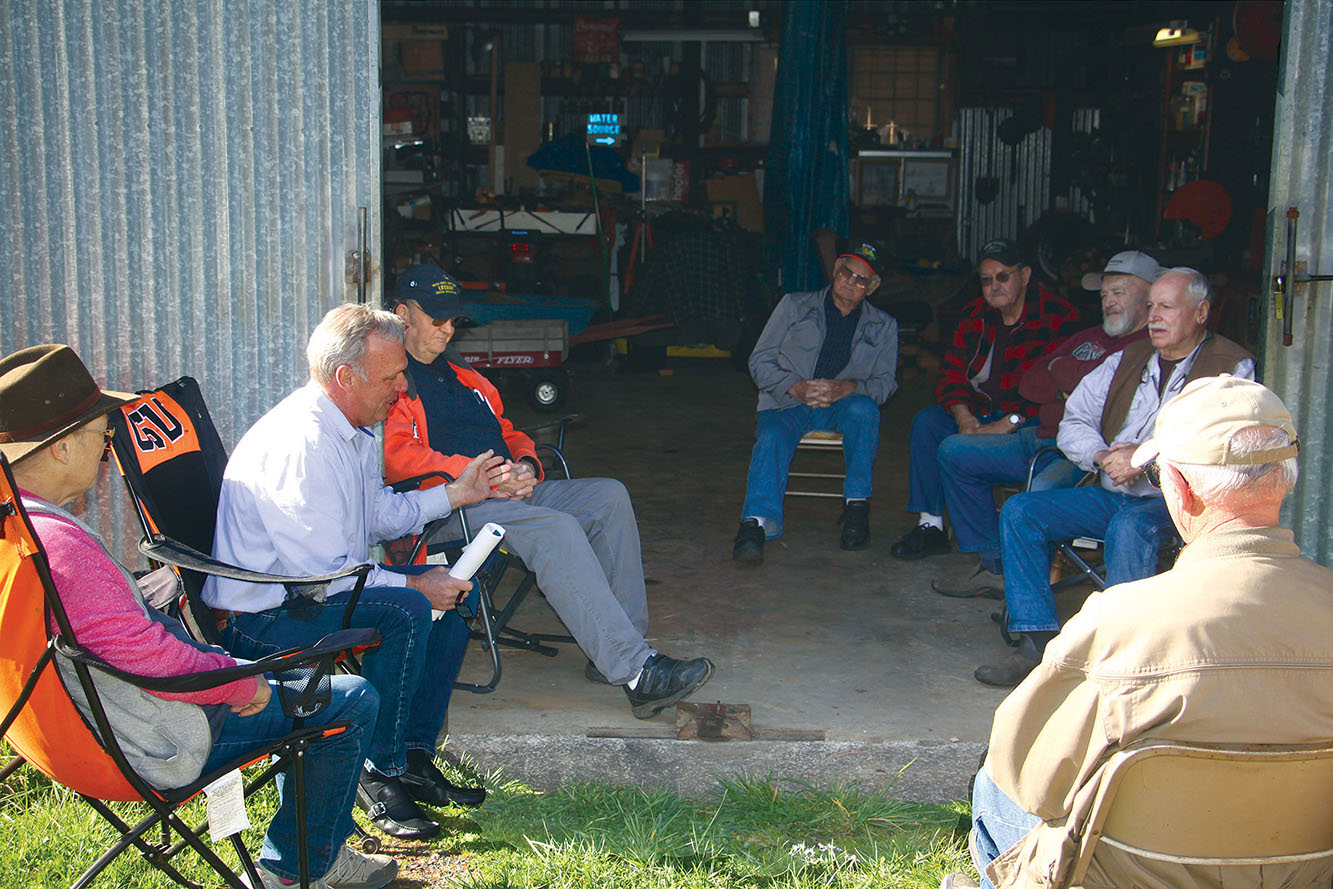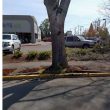By Scott Swanson
Of The New Era
Linn County Commission Chair Roger Nyquist told a group of local retirees last week that the $1 billion timber lawsuit Linn and 12 other counties won against the Oregon Department of Forestry last November unveiled a dearth of data behind the state’s forest management decisions.
Nyquist paid a visit Wednesday, March 4, to the group, mostly former loggers, who gather weekly in Holley. He was invited by Bruce Weatherly, one of the participants.
Their hour-plus-long conversation ranged past the county’s lawsuit, which was decided Nov. 20, 2019, to the cap-and-trade bill and other ways state government has impacted the rural population.
Nyquist gave a play-by-play inside account of the trial, which he said he personally didn’t think would actually happen.
He told how Commissioner John Lindsay had been threatening state government officials “once in a while” with a lawsuit since before 2000, when Nyquist took office.
“He was the tree policy guy. He went to DC and he went to the capitol and he told them what idiots they were for how they were managing the resource. And he was right; but nobody really listened to him.”
Nyquist said he would be personally disturbed when he visited the Santiam Canyon area, where his mother grew up, and saw the economic devastation there, caused by the shutdown of state and other forestry operations.
“When I was going home, I didn’t feel very good about, in particular, how those communities had been treated by federal and state government, partly because 20,000 acres of our state forests are right up there, just east of that canyon area.”
When the county was approached in 2015 about the possibility of suing ODF for violating the terms of the Forest Acquisition Act of 1941, a contract with the counties, which required the state to manage the forests for the “greatest permanent value of such lands” in exchange for receiving some 600,000 acres of logged-over and burned forest lands from the counties.
As a condition of the lands transfer, which now comprise the bulk of Oregon’s state forests, the state agreed to rehabilitate them, protect them from fire and share a portion of timber revenues with the counties when they became productive again.
Jury selection and arguments in the trial lasted 20 days, and Nyquist said he was surprised to find himself sitting with the counties’ attorneys at the plaintiffs’ table in District Judge Thomas A. McHill’s Linn County courtroom.
“They didn’t tell me until the night before the trial that I would be sitting there at the table with them,” Nyquist said. “I planned on attending, but I didn’t plan on being that active. I’m not an attorney. I figured they knew what they were doing. So it was pretty intense stuff.”
Things got interesting right away when, during jury selection, nearly all the prospective jurors were dismissed, who were old enough to have actually witnessed the devastation caused to local communities by new forest policies.
“We wound up with a jury, half of them were under 35 years of age, four of them were under 25.”
He said a key piece of evidence in the trial was a video showing former Gov. John Kitzhaber telling state foresters in a 1998 meeting that “he wasn’t comfortable with timber production being the primary focus of (state forests). He went to the Department of Forestry and said ‘You need to pass a rule here that puts environmental concerns on an equal playing field with timber production.’”
That resulted in changes in forest management policy that halved the timber production from state forests, Nyquist said.
It became obvious early on, he said, that the state’s policies weren’t based on actual data.
“One of the state’s experts testified that trees grow at a rate of 2.8 percent a year. My attorneys were good at the law, but they weren’t really good at math.
“They didn’t grow up in a bowling alley where they had to keep score by hand,” added Nyquist, whose parents bought an Albany bowling alley when he was 10, drawing chuckles from his audience.
“It took me just a couple of minutes to figure out that was 37 or 38 years and you were at 100 percent growth rate. If you cut every 38 years, you still would be never losing your volume of trees.”
“The state had implemented a 70- to 90-year model because they were trying to grow endangered species habitat. Have you seen the movie ‘Field of Dreams?’ The theme was ‘If you build it, they will come.’ They were cutting trees down because they were trying to create more spotted owl habitat which, one, was a loser in Linn County. The other problem they had was the owls never showed up. But even given all of that, they refused to change their policy. That was clear during the trial.”
At another point during the proceedings, the state’s attorneys showed an aerial photo of the state’s forestland in the Crabtree District.
“Some was logged, some of it was ready, some was in growth,” Nyquist said. “They said, ‘Here’s your Linn County forest” and I looked at that photo and I said, “What the hell am I doing here? It looks like they’re doing their job.”
During a break he found the county’s GIS specialist and asked to see a map of the Santiam Canyon area, where the other state forestlands in Linn County are located.
“You can tell by the color from the aerial whether stuff’s been harvested,” Nyquist said. “There were no cuts showing in that area. And that was about 90 percent of our total forest, not the 10 percent that they had done right. So we flipped that on them.”
ODF’s final witness was a forester who managed that property.
“She said we’re on a 70- to 90-year cycle here. Well why? What data do you base that on? ‘Well, I just think it’s best.’ In essence, she was saying ‘it’s prettier.’”
ODF did argue that those older trees were being sold as power poles, Nyquist added, drawing guffaws from his listeners, one of whom exclaimed, “Come on!”
“They said it over and over and over,” Nyquist said. “‘Those trees are going to your plant in Brownsville. That’s a Linn County business. Why do you hate that business?’
“Again, we did that data. We asked, ‘What percent of the market is power poles?’ Well, they didn’t know. ‘It’s less than 1 percent, right?’ I guess I’ll just leave it at that.”
Closing arguments were “pretty intense,” Nyquist said.
“The state’s attorneys blamed it on our lawyers, saying our lawyers were just greedy people, that if not for them, people wouldn’t have had to waste three weeks (sitting through the trial).
The counties’ lawyers presented numbers on what the losses had been since forest management policy changed.
“We had a big board that showed the number by county. The state’s position was ‘no, there’s zero loss. There’s zero impact. The number is zero,’ which was a big gamble on their part.”
The wait for a verdict was a “nervous” one, and Nyquist said he was the first one into the courtroom after they heard a verdict had been reached and he’d strategized how he would make a quick exit from the courtroom if things went south.
But the $1,065,919,400 verdict revealed that young jurors “got it,” when presented with evidence about the state’s forestry practices and the devastation it has caused rural communities such as Sweet Home and the Mill City-Lyons area, he said.
“When they read those numbers, the jury gave us every dollar we asked for. Every dollar. They had no other alternative. They must have been able to do that math. A tree growing at 2.8 percent a year for 38 years is a crop ready to be harvested. The state had no scientific or practical methodology to back up their harvest plans. We had the governor’s video front and center, which was probably an important part of what had happened.
“I’m still emotional now as I think about it, that the jurors got it. They absolutely got it. It’s easy to underestimate the impacts of logging and the wood products industry on our county. A couple of those younger people were from Lebanon. I suspect their parents and their grandparents know this story really well – not that they talked with them during the trial, but for me that was a very neat part of all of this, that they absolutely got it.
“The skeptic would say that anybody who had to sit there for 20 days would be mad at who made them sit there, which was us. We brought the suit. They were great.”
He said support from the community has been “remarkable.”
“During the entire time I had one call of objection. It was as the thing was starting and he was asking ‘Where are you going to get the money?’ and ‘They’re just going to increase our taxes. This is not a productive use of your time, Roger.’
“I said, ‘Hey look, I don’t think it will ever get there, I’m taking your name and number and I’ll call you the day that happens. I stuck it on my bulletin board. He was the only one, out of 120,000 people, who objected. I did call him. He was as happy as I was. He’d followed it. A contract is a contract; if they violate it, they pay. It’s been a really neat experience in that regard as well.”
The case has been appealed to the state Court of Appeals and Nyquist said it will probably be a couple more years before a decision is handed down. Then the case will likely be appealed to the state Supreme Court, which will take a couple more years. Meanwhile, interest is accruing at 9 percent a year – $8 million per month.
He told the group it could be five years before Linn County, whose share of the award would be a base amount of $65 million,
Asked by one of his listeners where the money to pay would come from, Nyquist noted that, instead of taxing state residents, as has been suggested by state officials following the verdict, the Oregon Lottery has $500 million in bonding capacity and $500 million in reserves.
“They’ve spent hundreds of millions on light rail in Portland, of lottery-bonded money. So why shouldn’t they spend that money in rural Oregon, in communities they’ve helped devastate?
“We certainly could work out an arrangement that it isn’t all (paid) at once.
“The other thing is, many of the assets are still standing in the forest. They could generate a lot of that money by cutting down trees.”
“There’s trees that need to be cut down,” said Les Namitz from the audience.
“You’re right,” Nyquist responded. “They can cut them down or they’re going to burn.”
Liz Gentino asked whether the push for the cap-and-trade bill in the legislature is an effort to punish the rural counties for their court victory.
Nyquist noted that the cap-and-trade effort was under way long before the court case was decided.
“They’re doing that because it’s pure politics,” he said. “They’re doing that because their political base supports that kind of action. It’s a bit crazy, isn’t it? You’ve got people thinking that in 11 years they’re going to burn up? How do you have that conversation?”
He said he’s been told that if a statewide measure on cap-and-trade were put to voters, “it would lose 3-1 today.
“People get that. People get raising their price a buck a gallon for an environmental cup of water in the ocean is not something that makes sense.”
Ed Graville asked what a cap-and-trade law would do to farmers and others who own less-than-modern equipment.
“What about these pickups?” he asked, gesturing at the cluster of vehicles parked outside the workshop in which they were sitting.
Nyquist reponded: “I pulled up in a 2001 Ford Excursion diesel with 400,000 miles on it. I don’t think I’m going to give that up.
“No, it’s not good. A big part of the problem with cap-and-trade, with their bill, they leave the details blank. They just tell you you’re going to get to a goal. They don’t put in all the gory details of how you’re going to get to the goal, necessarily. You know the math. There’s only one way to get there: electricity.”
He acknowledged that if cap-and-trade passes, it will be difficult – for everyone.
“My dad is 84. I farm 100 acres with him. It will be a bad day for a state bureaucrat to come out and tell my dad to shut that tractor down. It’s not going to work out for somebody.
“The problem is that’s not how they’ll do it. What they’ll do is pound the cost of that fuel, so our fuel will go out. The fuel bill will be a disproportionate cost of planting 100 acres of wheat. The lack of detail and how they get there.”




